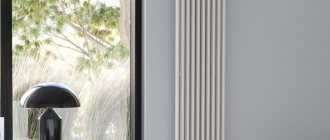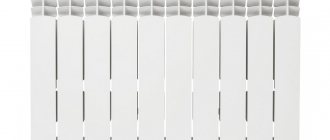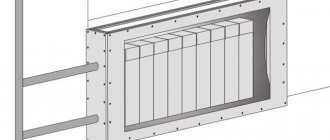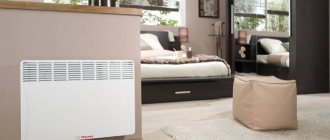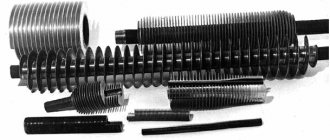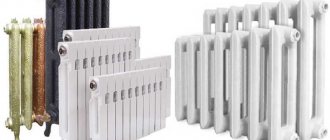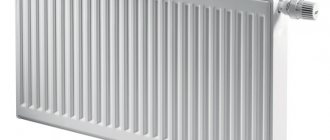Modern canons of interior design and comfort dictate rather strict conditions for the installation of all life support systems in homes and offices. A particular problem in this case is the room heating system, because you can’t hide it inside a wall or behind partitions, you can’t just discard it and take it to utility rooms, the heat must be supplied constantly and as efficiently as possible. To solve these issues, there are vertical radiators.
Installation Features
Due to the physical characteristics of the distribution of warm air, certain requirements apply to the placement of heating radiators. Traditionally, they are installed under windows, below the window opening, to block the flow of cold air from the window and keep the room warm. What to do if the windows are panoramic, or the part of the wall from the floor to the window sill is too small to install the battery?
Vertical heating radiators for an apartment or office with panoramic windows and low window sills are an ideal solution to retain heat and implement many interior solutions. They are also suitable if the area where wall batteries should be installed is too narrow for the installation of traditional options.
Also, do not discount the design of the room - many models can please you not only with practical functions, but also perfectly serve as decorative elements to complement the interior.
The most common connection difficulty is the need for a lower connection and coolant outlet. This affects heat exchange at low coolant temperatures and the presence of air in the pipes, but eliminates the need for wall slitting or unaesthetic appearance of pipes on the walls. If the connection is made in an apartment or office with central heating, then the difference in heat transfer is completely unnoticeable, and to bleed off excess air, all radiators are equipped with special fittings or automatic valves.
Also, installation features include restrictions on wall material. Heavy radiators cannot be installed on walls made of low-strength materials; this threatens not only a utility accident, but also the destruction of a partition or wall.
APPENDIX: How to determine the required thermal power of a heating radiator
A radiator is always selected for a specific room, as it is installed and connected to the heating circuit permanently in the hope of many years of use. This means that it is important to choose the right model so that its thermal output is sufficient to warm up this room. Or, if we are talking about a collapsible model, it is necessary to determine the required number of sections.
A very common statement is that to determine the heating power, it is enough to divide the area of the room by 10 and get the ready value in kilowatts. Based on the calculation that 100 W of thermal energy is required per 1 square meter.
It must be said that this approach is too approximate. The fact is that the need for heat supply depends not only on the area of the room. The main task of the heating system is to compensate for heat losses, but their amount depends on many factors.
Therefore, we advise you to use a more detailed and advanced algorithm for calculating the required thermal power. It is implemented in the online calculator we offer.
If questions arise when using the calculator, the reader will find some recommendations for performing the calculation below.
Calculator for calculating the required power of heating radiators
Go to calculations
Main types of radiators
Based on the material of manufacture and design, vertical radiators are divided into several main types:
Cast iron radiators
Classically verified and long ago becoming traditional, the material is not always used for the production of unpresentable “accordions”. Modern options can have a stylish look, corrugated or smooth surfaces, a variety of colors, decorated with casting and blackening, and fit not only into rooms in a “retro” or “Soviet” style.
Today they are produced using artistic casting technology, complemented by suitable taps, plugs, stands and holders. These are tall radiators rather than vertical ones because cast iron retains heat well and there is no need for a large surface area. Their disadvantages are the instability of cast iron to directed strong point impacts and heavy weight, so the sections are quite difficult to securely fasten to walls or partitions; they are equipped with legs and stand on the floor in addition to wall fastenings.
Steel radiators
Steel radiators have high heat transfer, heat up very quickly, are lightweight and easy to install, regardless of the size and number of sections. However, due to their design, they do not withstand water hammer, and when connected to a central heating system, they can become a source of leaks. Rapid cooling makes them energy-intensive and unsuitable for autonomous heating systems. They are divided into three types: panel, tubular and sectional.
Vertical panel radiator
Vertical panel radiator is the most popular model. A neat appearance, smooth surface, many shade options and the ability to hold independently applied designs allow them to harmoniously fit into any interior in the form of decorative panels.
Models with convectors create an excellent thermal curtain when placed under windows. Vertical radiators of this type are often installed under alpine vents, skylights, or to heat staircases and interfloor passages in private homes. If the apartment has only one floor, then a convector is not needed, since the thermal curtain will be created under the ceiling, and the cost of models without it is much less.
Tubular vertical batteries
Tubular vertical batteries look very original and allow you to create structures up to three meters in height, which is perfect for rooms with high ceilings. They can have any color, shape (even twisted ornaments and crossed knots) and bends, as they are made from separate pipe sections and connected by welded manifolds, which allows them to satisfy the most picky designers. Such designs rarely have sharp corners and are safer for children's rooms. The presence of welded seams also makes them vulnerable to water hammer, so the likelihood of leaks in centralized heating systems is high.
Sectional batteries
Sectional batteries made of steel do not have very high performance parameters, but they are attractive due to their low price and detachable design. The ability to change a section, increase or, conversely, reduce the surface is sometimes decisive when purchasing. Sections are not produced above two meters and look very neat in appearance, and they are often given the appearance of artistically designed panels. Very low weight allows connection and installation on walls and partitions made of low-strength materials.
Vertical radiators
Vertical radiators made of aluminum are quite capricious regarding the quality of the coolant, they are characterized by uneven heating of the structure, and not all models have an anti-corrosion coating. However, they are relatively easy to install, light in weight, have a high heat transfer coefficient and are aesthetically pleasing.
There are models in the production of which an anodizing cycle is added - they tolerate high pressure well and do not require high-quality coolant, but their price is much higher than usual.
The advantage of such radiators is that the number of sections for each room is calculated separately, so in small rooms you can often find narrow radiators.
The shelf life of aluminum non-removable radiators is typically stated to be from 20 to 25 years, but with proper care they can last much longer. The manufacturer gives a shorter warranty period for collapsible structures, but they can also last a very long time with high-quality coolant and proper operation.
Vertical bimetallic radiators
Vertical bimetallic heating radiators are considered the most efficient and reliable. They are made of internal pipes made of stainless alloy or copper, which are in direct contact with the coolant and an external heat exchange casing made of aluminum with an enamel coating. Outwardly, they are no different from aluminum radiators, but significantly superior to them in performance, which is especially valuable at the height of the heating season, and justifies their higher cost. Installed in an apartment with a central heating system, they can prevent leaks due to pressure changes in the pipes.
Structurally, there are also collapsible and non-dismountable options, each of which is designed for a certain thermal power, and most models are equipped with thermostats. Many examples of vertical radiators, including designer models, can be seen on the KZTO website.
Review of popular models
On today's market there is a large selection of different models, produced mainly by foreign and some Russian manufacturers.
Here is a comparative table of the main technical parameters of the best vertical tubular radiators.
| Model | Arbonia 2180/10 | Accuro-korle 304 L AISI | COPPERI Plain CPV-1800-500 | Zehnder Nobis NOB-150-050 | Astra E 1104 |
| Manufacturer country | Switzerland | Türkiye | Italy | Germany | Russia |
| Material | steel | stainless steel | pipes - copper, body - stainless steel | chromium | stainless steel |
| Height, cm | 180 | 150 | 180 | 152 | 113 |
| Width, cm | 45 | 46 | 50 | 45 | 40 |
| Thickness, cm | 6.5 | 5.7 | 10 | 5.8 | 5.4 |
| power, kWt | 1.67 | 1.7 | 1.15 | 0.29 | 0.58 |
| Heated area, sq.m | until 19 | up to 20 | up to 16 | up to 6 (towel rail) | up to 10 (towel rail) |
| Working pressure, atm. | 10 | 16 | 16 | 12 | 15 |
| Approximate cost, rub. | 19 100 | 52 200 | 44 600 | 61 500 | 17 500 |
The cost is influenced by the power, material of manufacture and originality of the heater design, as well as the popularity of the manufacturer’s brand. Wall-mounted radiators of Russian brands traditionally have a much lower price with fairly good quality and reliability.
Advantages and disadvantages
The positive aspects of a vertical radiator include both practical and aesthetic design features:
- Rational use of indoor space. Greater thermal power can be fit into a rather narrow wall space by increasing the vertical heat exchange area.
- Propagation of thermal radiation over the entire height of the battery. The location and height of the heating radiator itself can bring many pleasant moments to a person, especially when entering a room from the cold.
- The maximum range of models that will allow you to implement any design solution.
- Additional functions allow you to turn heating radiators into vertical mirrors, clothes dryers, decorative partitions and panels.
- Due to the smaller movement of warm air from the lower layers to the upper layers in the room, the movement of dust is also limited.
New items in the model range in the form of a mirror frame, a solid or lattice wall panel, a matte or painted partition are increasingly finding their fans among room designers, and variations in sizes from very narrow to very wide allow you not only to correctly adjust the temperature in the room, but also to direct warm.
Of course, such extraordinary solutions also have disadvantages:
- Heat transfer is built irrationally. That is, the top of the room is warmer than the bottom due to the accumulation of warm air under the ceiling. However, many people find some advantages in this in the form of warm stairs and interfloor passages, which perfectly heat the installed radiators on the lower floor.
- High probability of air pockets.
- Connection difficulties. It is necessary to carefully hide all supply pipes and fastenings to maintain an aesthetically pleasing appearance. Vertical and horizontal deviations are also unacceptable. It is necessary to use a bottom connection, which is rarely optimal for heat transfer.
- The requirements for high wall strength come from the massiveness of the structure. The radiators are quite large in size, and although they seem quite light without filling, their weight, including water, is quite large. This imposes some restrictions on placement on the walls.
- The cost of vertical models is often much higher than the price of traditional options.
Today's wealth of shapes, layouts and variations of interiors cannot be heated by every horizontal heating element, so installing vertical heating radiators in many cases serves as a salvation. A variety of models and designs provide an excellent opportunity to competently combine rationalism and creativity, because such unusual and attractive designs will serve well for many years.
No. 1. What do you need to consider?
The radiator, which some are not shy about comparing to a log in the eye, performs the most important function , and we must not forget about it, because it is impossible to survive a harsh winter without proper heating. That is why all attempts to decorate a radiator should not go beyond the bounds of common sense.
When deciding how to disguise a heating radiator, it is worth considering the following nuances:
- whatever the decor, the main function of the battery should not be impaired - to heat, so even if the radiator is covered with a screen, there must be holes in it, and the more, the better. It is also advisable to provide gaps under the window sill and near the floor so as not to interfere with the normal circulation of air;
- the radiator and threaded connections must remain in the accessible area, so it does not hurt to provide a small window if the screen is not removable;
- the tap, thermal head and other elements for controlling and adjusting the coolant supply must be easily accessible for repair work if necessary.
The easiest way to get an inconspicuous battery and 100% preserve all its functions is to buy a designer radiator. Such products are made to order and fully match the design of the room. The downside is the high price, which forces you to look for more affordable options.
No. 9. Several original ideas
If standard solutions for some reason do not suit you, you can use more original methods:
- stretch fabric to match the walls over the picture frame The option is naturally suitable for radiators located in a niche;
- Blinds are a very unusual way to hide a radiator, but in some cases it has a place. Installation work is minimal;
- creating a false fireplace above the heating radiator. The frame of the fireplace can be made of plasterboard or plywood, and the hole can be covered with a metal grate. With proper finishing, the structure will closely resemble a real fireplace, and in winter real heat will come from there.
Connection type
The most common is the bottom connection . Installing the radiator in a vertical position with such piping is not difficult, but the installation of the pipes will take place inside the wall or covered with a decorative box. All this leads to higher construction costs.
Lateral connection is used much less frequently . It does not give much effect due to the fact that the coolant is not completely removed from the radiator and can remain there even in summer. This affects the durability and quality of the device.
The most effective is considered to be a diagonal connection, which has an upper input and a lower output.
Radiator dimensions may vary. This value does not have a strict standard. The height of the device is in the range of 0.3−6 m, and its width is in the range of 0.3−3 m. Multilayer devices are sometimes produced.
The principle of constructing a heating system
Speaking about the operating principle of the heating scheme for multi-storey buildings, a few words should be said about its construction. It's actually quite simple. Most modern houses use a single-pipe centralized heating scheme for a five-story house or a house with fewer/more floors. That is, the heating scheme of a 5-story building is a single (for one entrance) riser, in which the coolant can be supplied both from below and from above.
In accordance with the location of the supply element, there are two types of coolant orientation. So, provided that the supply pipes are located in the basement, there is a counter-movement of the coolant. And if the supply element is in the attic, then the direction is in the same direction.
Many people are interested in how to determine the radiator area for a particular room. In fact, everything is quite simple - you just need to take into account the cooling rate of the coolant used (water).
Most of us mistakenly believe that the higher the house, the more complex and confusing the heating scheme of a multi-storey building is. But this is a wrong opinion. In fact, the calculation of heating in an apartment building is mainly influenced by the number of apartments that need to be heated.
1. 2. 3. 4. 5.
An apartment in a multi-storey building is an urban alternative to private houses, and a very large number of people live in apartments. The popularity of city apartments is not strange, because they have everything a person needs for a comfortable stay: heating, sewerage and hot water supply. And if the last two points do not need special introduction, then the heating scheme of a multi-storey building requires detailed consideration. From the point of view of design features, the centralized one has a number of differences from autonomous structures, which allows it to provide the house with thermal energy during the cold season.
Solving possible problems
Regardless of whether you bought a vertical bimetallic or steel radiator, problems may arise during operation. And the point here is not in the battery itself, but in the coolant, the correct installation of the circuit, and the human factor. Various things can happen, but the most common problems are:
- pollution;
Pipes can also become clogged.
- airing;
- a leak.
If the battery is dirty (deposition of debris and scale formation), then it heats worse. The reason for this is poor-quality coolant, the pH level of which is too high. If the bottom of the battery is cold, then we can say with 100% certainty that there is sediment in it. To remove dirt, you need to remove the battery from the circuit and rinse it using a booster to clean heat exchangers. This is a chemical method. In addition to this, there is a method of pulse and pressure cleaning, but they require more expensive equipment.
If there is air in the batteries, the top will be cold. The air lock can be removed through the Mayevsky valve installed at the top end. The valve must be present; the absence of an air vent is a gross violation of the rules for installing the battery. If a leak appears, you should immediately call a plumber.
Battery replacement options
- Batteries with pipes are built into the facade walls.
Most likely, any work in this case will be strictly prohibited. After all, the design of the building includes heat from these pipes along the facade. And any individual changes are simply unacceptable. The only solution would be to order a rework of the heating system throughout the house with insulation of the external walls. It will be necessary to break through the ceilings, install risers, and only then connect new radiators to them.
- Piping in internal slabs.
There are serious restrictions on load-bearing walls. As a rule, batteries were embedded in them. And any demolitions or penetrations are not allowed. The only thing that can be done is to find “mortgages” in the corners of the slabs. These are pockets in the concrete where the slabs and heating risers were connected to each other. These places are easy to find by tapping. After connecting the pipes, the voids were filled with a solution, which sounds very different from industrial concrete. Then the coil in the wall is tightly closed and a new radiator with a bypass is inserted.
- The batteries are inside, but there are riser outlets outside.
In some series of houses, although the radiators are located in the walls, pipe bends can be seen in the corners of the rooms. Everything is much simpler here. It won't be difficult to get close to them and crash into the system. In addition, you don’t have to create a project and go through lengthy approvals.
Whatever the situation, you need to clearly understand that the battery embedded in the wall is in fact a common riser for the entire entrance. And any changes in it affect the quality of heating for all neighbors above and below. Whatever is done, the riser must not be blocked or narrowed.
Only a specialist can accurately determine the series of the house and the configuration of the pipes inside the panels. It will be necessary to bring up documents of Soviet projects. You can only roughly find by touch where such a battery is located.
All this work will cost a lot of money. But problems with heat can be completely different.
Before “removing” the radiators from the walls, you should contact the house management company and demand that they identify the reasons for the lack of heat in the rooms. It is possible that an air lock has simply formed in the embedded pipes or there are deficiencies in the sealing of the seams. Or the insulation inside the panels has simply decayed over time. In many cases, they will fix the problems without reworking the heating system or will have to install an external radiator for free.
Primary treatment of the wall behind the battery
The picture above clearly shows that the wall behind the battery has not been treated. If you are removing the battery for the first time, then most likely there will not be a white wall at all, but a gray dusty wall, with old, stubborn paint. It is clear that you cannot immediately put wallpaper on such a wall. If you are planning not to glue wallpaper, but to cover the wall with a decorative panel, as can be clearly seen in the pictures in the article, then in any case, the wall needs to be treated at least in order to remove the smells of old walls and old renovations (advice from my personal experience ).
So where to start? We begin to knock off the extra bumps on the wall, the remains of the old putty and paint with a hammer and chisel. We especially go through those places where we need to attach the baseboard. Planned time about 1 hour:
Then you must remove all debris and prime the wall (see section).
We prime the wall 2 times. The priming itself takes 10 minutes, but the drying time for each layer is 1.5 hours.
Total: cleaning + priming the wall + drying time is about 4 hours.
Blitz tips
Vertical batteries made of polished stainless steel require constant surface care. Even the smallest mark or traces of water flow on the surface create a negative impression.
To clean, simply use a neutral detergent for shiny surfaces and a soft cloth.
The difference in temperature of such a radiator at the top of the device and at the bottom sometimes reaches 5-7 degrees Celsius. This temperature difference indicates good heat transfer and excellent battery performance.
The installation of a thermostat that allows you to regulate the temperature of the coolant can improve the operation of such a device and significantly save on payments for consumed resources.
It is useful to know that, unlike standard radiators made of aluminum casting, which have a wall thickness of only 1, vertical registers have a wall thickness increased to 2 mm, which significantly increases their service life.
To give the interior more dynamism, a flat vertical radiator can be decorated not only with an interior sticker, but also by ordering a special metal grille with a perforated pattern.
Such an overlay will not change the heat transfer of the radiator, but will give the room a new look.
No. 10. What to do with heating pipes?
Pipes must lead to the radiator. As a rule, there are no problems with them, since they are not as noticeable as a radiator, and in most cases it will be enough to paint them in the color of the walls . If you choose the method of installing drywall, then there will be no problems with the pipes - they will already be hidden under the sheets of the structure.
An alternative to painting pipes is decorating . They can be wrapped with jute or hemp rope, decorated with artificial leaves or flowers. High horizontal pipes are hidden under curtains, and low ones are hidden under floor skirting boards.
